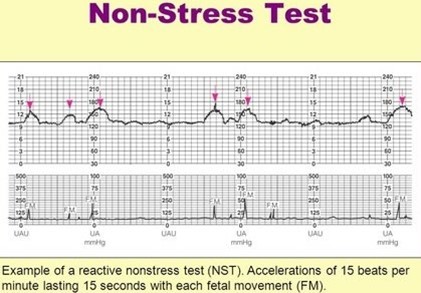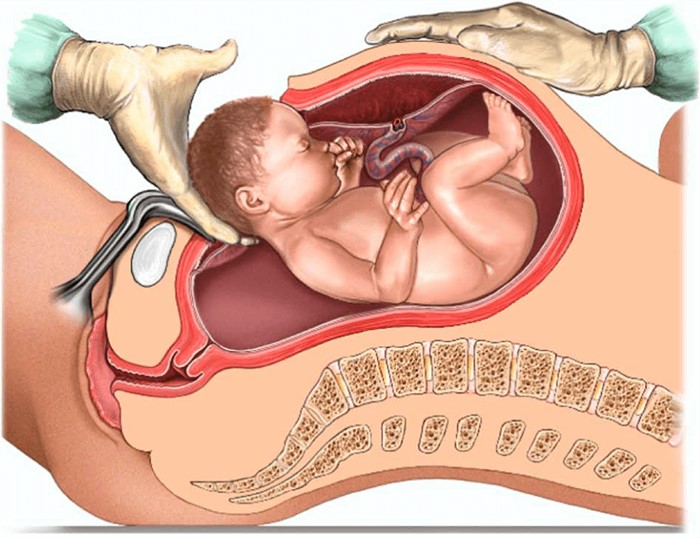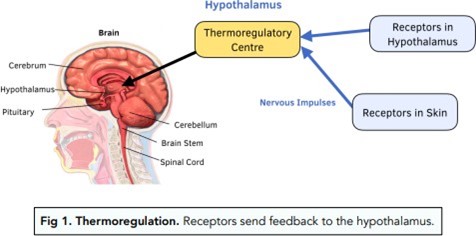The nurse is reading the results of non-stress test (NST) strips completed that day. Which of the following strips meets the criteria for a reactive NST? Select one:
A fetal heart rate baseline of 140 with one acceleration to 155 for 15 seconds within 30 minutes.
A fetal heart rate baseline of 140 with two accelerations to 160 for 15 seconds within 20 minutes.
A fetal heart rate baseline of 130 with two accelerations to 135 for 15 seconds within 20 minutes.
A fetal heart rate baseline of 150 with two accelerations to 160 for 10 seconds within 20 minutes.
The Correct Answer is B
Choice A Reason: A fetal heart rate baseline of 140 with one acceleration to 155 for 15 seconds within 30 minutes. This is an incorrect answer that indicates a non-reactive NST, which is a test that does not meet the criteria for a reactive NST. A non-reactive NST may suggest fetal hypoxia, distress, or sleep, but it does not necessarily indicate a problem. A non-reactive NST may require further testing or stimulation to elicit a reactive result.
Choice B Reason A fetal heart rate baseline of 140 with two accelerations to 160 for 15 seconds within 20 minutes. This is because this strip meets the criteria for a reactive NST, which is a non-invasive test that evaluates fetal well- being and oxygenation by measuring the fetal heart rate response to fetal movements. A reactive NST is defined as having at least two accelerations of the fetal heart rate that are at least 15 beats per minute above the baseline and last for at least 15 seconds within a 20-minute period.
Choice C Reason: A fetal heart rate baseline of 130 with two accelerations to 135 for 15 seconds within 20 minutes. This is an incorrect answer that indicates a non-reactive NST, which is a test that does not meet the criteria for a reactive NST. The accelerations in this strip are not sufficient in amplitude, as they are only 5 beats per minute above the baseline, instead of at least 15 beats per minute.
Choice D Reason: A fetal heart rate baseline of 150 with two accelerations to 160 for 10 seconds within 20 minutes. This is an incorrect answer that indicates a non-reactive NST, which is a test that does not meet the criteria for a reactive NST. The accelerations in this strip are not sufficient in duration, as they last only for 10 seconds, instead of at least 15 seconds.

Nursing Test Bank
Naxlex Comprehensive Predictor Exams
Related Questions
Correct Answer is D
Explanation
Choice A Reason: Preterm infant. This is an incorrect answer that confuses TTN with another respiratory condition called respiratory distress syndrome (RDS). RDS is a serious condition where the newborn's lungs are immature and lack sufficient surfactant, which is a substance that reduces surface tension and prevents alveolar collapse. RDS can cause respiratory distress, hypoxia, acidosis, and organ failure. It is more common in preterm infants, especially those born before 37 weeks' gestation.
Choice B Reason: Female infant. This is an incorrect answer that has no evidence or rationale to support it. TTN does not have a gender preference or difference in incidence or severity.
Choice C Reason: GBS status of mother. This is an incorrect answer that relates to another respiratory complication called early-onset neonatal sepsis (EONS). EONS is a bacterial infection that occurs within 72 hours after birth, which can affect multiple organs and systems in the newborn. EONS can be caused by group B streptococcus (GBS), which is a common bacterium that colonizes in some women's vagina or rectum. GBS can be transmited to the newborn during delivery and cause pneumonia, meningitis, or septic shock.
Choice D Reason: Cesarean section. This is because cesarean section is a risk factor for TTN, which is a mild respiratory problem that results from delayed clearance of fetal lung fluid after birth. TTN causes rapid breathing, nasal flaring, grunting, and mild cyanosis. It usually resolves within 24 to 48 hours after birth. Cesarean section can increase the risk of TTN because it bypasses the normal process of labor, which helps squeeze out some of the fluid from the fetal lungs.

Correct Answer is A
Explanation
Choice A Reason: Place the infant skin to skin with the mother and re-check temperature in 30 minutes. This is because skin-to-skin contact is an effective and safe method of increasing the infant's temperature and promoting thermoregulation. Skin-to-skin contact also has other benefits such as enhancing bonding, breastfeeding, and maternal-infant attachment.
Choice B Reason: Check the infant's CBC and blood cultures, as this is a sign of probable sepsis. This is an unnecessary action that may cause undue stress and discomfort to the infant and the mother. A slightly decreased temperature in a full-term infant is not a sign of probable sepsis, but rather a common finding that may be due to environmental factors, such as exposure to cold air or wet linens.
Choice C Reason: Return the infant to the nursery for close observation under warming lights. This is an undesirable action that may interfere with the early initiation of breastfeeding and bonding between the mother and the infant. Warming lights are not recommended for routine use in healthy newborns, as they may cause dehydration, hyperthermia, or eye damage.
Choice D Reason: Notify the physician immediately and suggest orders for placement in an incubator. This is an excessive action that may indicate a lack of knowledge or confidence on the part of the nurse. An incubator is not indicated for a stable, full term infant with a slightly decreased temperature, as it may expose the infant to unnecessary interventions, infections, or separation from the mother.

Whether you are a student looking to ace your exams or a practicing nurse seeking to enhance your expertise , our nursing education contents will empower you with the confidence and competence to make a difference in the lives of patients and become a respected leader in the healthcare field.
Visit Naxlex, invest in your future and unlock endless possibilities with our unparalleled nursing education contents today
Report Wrong Answer on the Current Question
Do you disagree with the answer? If yes, what is your expected answer? Explain.
Kindly be descriptive with the issue you are facing.
